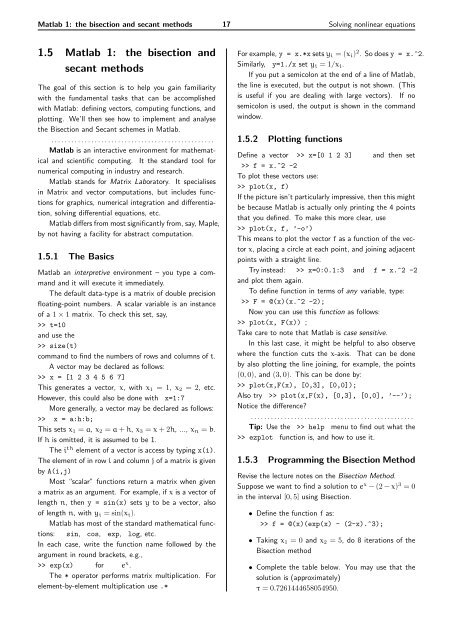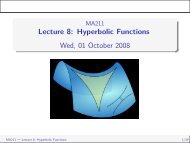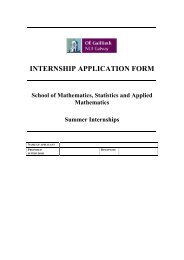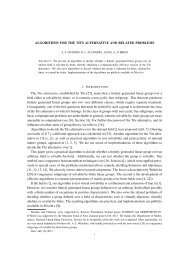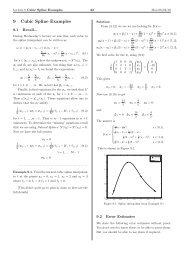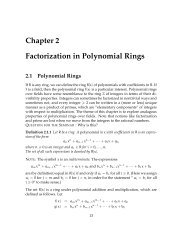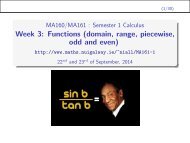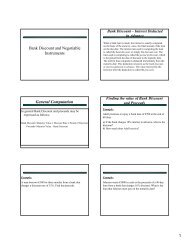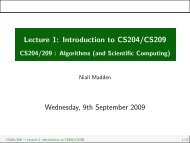Implementing the bisection and secant methods.
Implementing the bisection and secant methods.
Implementing the bisection and secant methods.
You also want an ePaper? Increase the reach of your titles
YUMPU automatically turns print PDFs into web optimized ePapers that Google loves.
Matlab 1: <strong>the</strong> <strong>bisection</strong> <strong>and</strong> <strong>secant</strong> <strong>methods</strong> 17 Solving nonlinear equations1.5 Matlab 1: <strong>the</strong> <strong>bisection</strong> <strong>and</strong><strong>secant</strong> <strong>methods</strong>The goal of this section is to help you gain familiaritywith <strong>the</strong> fundamental tasks that can be accomplishedwith Matlab: defining vectors, computing functions, <strong>and</strong>plotting. We’ll <strong>the</strong>n see how to implement <strong>and</strong> analyse<strong>the</strong> Bisection <strong>and</strong> Secant schemes in Matlab.. . . . . . . . . . . . . . . . . . . . . . . . . . . . . . . . . . . . . . . . . . . . . . . . .Matlab is an interactive environment for ma<strong>the</strong>matical<strong>and</strong> scientific computing. It <strong>the</strong> st<strong>and</strong>ard tool fornumerical computing in industry <strong>and</strong> research.Matlab st<strong>and</strong>s for Matrix Laboratory. It specialisesin Matrix <strong>and</strong> vector computations, but includes functionsfor graphics, numerical integration <strong>and</strong> differentiation,solving differential equations, etc.Matlab differs from most significantly from, say, Maple,by not having a facility for abstract computation.1.5.1 The BasicsMatlab an interpretive environment – you type a comm<strong>and</strong><strong>and</strong> it will execute it immediately.The default data-type is a matrix of double precisionfloating-point numbers. A scalar variable is an instanceof a 1 × 1 matrix. To check this set, say,>> t=10<strong>and</strong> use <strong>the</strong>>> size(t)comm<strong>and</strong> to find <strong>the</strong> numbers of rows <strong>and</strong> columns of t.A vector may be declared as follows:>> x = [1 2 3 4 5 6 7]This generates a vector, x, with x 1 = 1, x 2 = 2, etc.However, this could also be done with x=1:7More generally, a vector may be declared as follows:>> x = a:h:b;This sets x 1 = a, x 2 = a + h, x 3 = x + 2h, ..., x n = b.If h is omitted, it is assumed to be 1.The i th element of a vector is access by typing x(i).The element of in row i <strong>and</strong> column j of a matrix is givenby A(i,j)Most “scalar” functions return a matrix when givena matrix as an argument. For example, if x is a vector oflength n, <strong>the</strong>n y = sin(x) sets y to be a vector, alsoof length n, with y i = sin(x i ).Matlab has most of <strong>the</strong> st<strong>and</strong>ard ma<strong>the</strong>matical functions:sin, cos, exp, log, etc.In each case, write <strong>the</strong> function name followed by <strong>the</strong>argument in round brackets, e.g.,>> exp(x) for e x .The * operator performs matrix multiplication. Forelement-by-element multiplication use .*For example, y = x.*x sets y i = (x i ) 2 . So does y = x.^2.Similarly, y=1./x set y i = 1/x i .If you put a semicolon at <strong>the</strong> end of a line of Matlab,<strong>the</strong> line is executed, but <strong>the</strong> output is not shown. (Thisis useful if you are dealing with large vectors). If nosemicolon is used, <strong>the</strong> output is shown in <strong>the</strong> comm<strong>and</strong>window.1.5.2 Plotting functionsDefine a vector >> x=[0 1 2 3] <strong>and</strong> <strong>the</strong>n set>> f = x.^2 -2To plot <strong>the</strong>se vectors use:>> plot(x, f)If <strong>the</strong> picture isn’t particularly impressive, <strong>the</strong>n this mightbe because Matlab is actually only printing <strong>the</strong> 4 pointsthat you defined. To make this more clear, use>> plot(x, f, ’-o’)This means to plot <strong>the</strong> vector f as a function of <strong>the</strong> vectorx, placing a circle at each point, <strong>and</strong> joining adjacentpoints with a straight line.Try instead: >> x=0:0.1:3 <strong>and</strong> f = x.^2 -2<strong>and</strong> plot <strong>the</strong>m again.To define function in terms of any variable, type:>> F = @(x)(x.^2 -2);Now you can use this function as follows:>> plot(x, F(x)) ;Take care to note that Matlab is case sensitive.In this last case, it might be helpful to also observewhere <strong>the</strong> function cuts <strong>the</strong> x-axis. That can be doneby also plotting <strong>the</strong> line joining, for example, <strong>the</strong> points(0, 0), <strong>and</strong> (3, 0). This can be done by:>> plot(x,F(x), [0,3], [0,0]);Also try >> plot(x,F(x), [0,3], [0,0], ’--’);Notice <strong>the</strong> difference?. . . . . . . . . . . . . . . . . . . . . . . . . . . . . . . . . . . . . . . . . . . . . . . . .Tip: Use <strong>the</strong> >> help menu to find out what <strong>the</strong>>> ezplot function is, <strong>and</strong> how to use it.1.5.3 Programming <strong>the</strong> Bisection MethodRevise <strong>the</strong> lecture notes on <strong>the</strong> Bisection Method.Suppose we want to find a solution to e x − (2 − x) 3 = 0in <strong>the</strong> interval [0, 5] using Bisection.• Define <strong>the</strong> function f as:>> f = @(x)(exp(x) - (2-x).^3);• Taking x 1 = 0 <strong>and</strong> x 2 = 5, do 8 iterations of <strong>the</strong>Bisection method• Complete <strong>the</strong> table below. You may use that <strong>the</strong>solution is (approximately)τ = 0.7261444658054950.
Matlab 1: <strong>the</strong> <strong>bisection</strong> <strong>and</strong> <strong>secant</strong> <strong>methods</strong> 18 Solving nonlinear equationsk x k |τ − x k |12345678<strong>Implementing</strong> <strong>the</strong> Bisection method by h<strong>and</strong> is verytedious. Here is a program that will do it for you. Youdon’t need to type it all in; you can download it fromhttp://www.maths.nuigalway.ie/MA385/lab1/Bisection.m%% Using <strong>the</strong> Bisection method to find a zero of f(x)% Lab 1 of MA385clear; % Erase all stored variablesfprintf(’\n\n---------\n Using Bisection ’);% The function isf = @(x)(exp(x) - (2-x).^3);disp(’Solving f=0 with <strong>the</strong> function’);disp(f);%% The true solution istau = 0.72614446580549503614;fprintf(’The true solution is %12.8f’, tau);%% Our initial guesses are x_1=0 <strong>and</strong> x_2 =2;x(1)=0;fprintf(’\n\n%2d | %1.8e | %1.3e \n’, ...1, x(1), abs(tau - x(1)));x(2)=5;fprintf(’%2d | %1.8e | %1.3e \n’, 2, x(2), abs(tau-x(2)));for k=2:10x(k+1) = (x(k-1)+x(k))/2;if ( f(x(k+1))*f(x(k-1)) < 0)x(k)=x(k-1);endfprintf(’%2d | %1.8e | %1.3e\n’, k+1, x(k+1), ...abs(tau - x(k+1)));endRead <strong>the</strong> code carefully. If <strong>the</strong>re is a line you do notunderst<strong>and</strong>, <strong>the</strong>n ask a tutor, or look up <strong>the</strong> on-line help.For example, find out what that clear on Line 3 doesby typing >> doc clear . . . . . . . . . . . . . . . . . . . . . . . . . .Q1. Suppose we wanted an estimate x k for τ so that|τ − x k | 10 −10 .(i) In §1.1 we saw that |τ − x k| 1 2k−1|x1 − x 0 |.Use this to estimate how many iterations arerequired in <strong>the</strong>ory.(ii) Use <strong>the</strong> program above to find how many iterationsare required in practice.1.5.4 The Secant methodRecall <strong>the</strong> <strong>the</strong> Secant Method in (1.2.1).Q2(a) Adapt <strong>the</strong> program above to implement <strong>the</strong><strong>secant</strong> method.(b) Use it to find a solution to e x − (2 − x) 3 = 0in <strong>the</strong> interval [0, 5].(c) How many iterations are required to ensurethat <strong>the</strong> error is less than 10 −10 ?. . . . . . . . . . . . . . . . . . . . . . . . . . . . . . . . . . . . . . . . . . . . . . . . .Q3 Recall from Definition 1.2.4 <strong>the</strong> order of convergenceof a sequence {ε 0 , ε 1 , ε 2 , . . . } is q ifε k+1limk→∞ ε q = µ,kfor some constant µ.We would like to verify that q = (1 + √ 5)/2 ≈1.618. This is difficult to do computationally because,after a relatively small number of iterations,<strong>the</strong> round-off error becomes significant. But wecan still try!Adapt <strong>the</strong> program above so that at each iterationit displays|τ − x k |, |τ − x k | 1.68 , |τ − x k | 2 ,<strong>and</strong> so deduce that <strong>the</strong> order of converges is greaterthan 1 (so better than <strong>bisection</strong>), less than 2, <strong>and</strong>roughly (1 + √ 5)/2.Q4 (Bonus) The <strong>bisection</strong> method is popular becauseit is robust: it will always work subject to minimalconstraints. However, it is slow: if <strong>the</strong> Secantworks, <strong>the</strong>n it converges much more quickly. Howcan we combine <strong>the</strong>se two algorithms to get a fast,robust method? Consider <strong>the</strong> following problem:Solve f(x) = 1 −2x 2 − 2x + 2on [−10, 1].You should find that <strong>the</strong> <strong>bisection</strong> method works (slowly)for this problem, but <strong>the</strong> Secant method will fail. So writea hybrid algorithm that switches between <strong>the</strong> <strong>bisection</strong>method <strong>and</strong> <strong>the</strong> <strong>secant</strong> method as appropriate.Take care to document your code carefully, to showwhich algorithm is used when.How many iterations are required?1.5.5 To FinishBefore you leave <strong>the</strong> class send an email toNiall.Madden@NUIGalway.ie with your name, ID number,<strong>and</strong> answers to Questions 1, 2 <strong>and</strong> 3. For bonus credit,submit your solution to Q4 too. If you have worked insmall groups, you should still submit separate emails.


